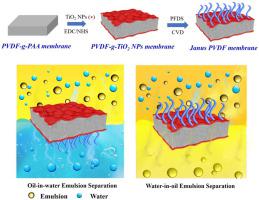Journal of Membrane Science ( IF 9.5 ) Pub Date : 2021-09-07 , DOI: 10.1016/j.memsci.2021.119837 Xihang Zhang 1 , Chenjie Wei 1 , Shuyan Ma 1 , Chengxiong Zhang 1 , Yang Li 1 , Dajing Chen 2 , Zhikang Xu 1 , Xiaojun Huang 1

|
Janus membranes, with extremely asymmetric wettability, superior flux and rejection, facile fabrication route, and versatile in complex environment, is urgently needed in fields of ideal oil/water separation. In this work, a facile poly (vinylidene fluoride)-graft-(TiO2 nanoparticles and 1H, 1H, 2H, 2H-perfluorodecyltri-ethoxysilane) (PVDF-g-(TiO2-PFDS)) membrane with loose architecture and asymmetric wettability was successfully fabricated by one-step surface grafting and further single-side chemical vapor deposition (CVD) strategies. Amino-functionalized TiO2 (TiO2–NH2) nanoparticles immobilized could not only improve surface energy and roughness of the PVDF-g-poly(acrylic acid) (PAA) membrane, but also decrease pore size adequately. PFDS was further deposited on one side of PVDF-g-TiO2 NPs membrane for constructing asymmetric interface. The fabricated Janus membrane showed superhydrophilic (a water contact angle of 0°) and superhydrophobic (a stable water contact angle of 151°) properties on forward/reverse surfaces. These characteristics endowed the membrane with high separation flux of ∼2500 L·m-2·h-1 under 0.1 MPa, and high rejection rate of above 99.70% for separating surfactant-stabilized dodecane-in-water and water-in-chloroform emulsions, respectively. Furthermore, the PVDF-g-(TiO2-PFDS) membrane showed excellent cycling performance during separation process. This work shows a potential way to fabricate Janus membranes with dual wettability for efficient oil/water separation facilely.
中文翻译:

具有松散结构和不对称润湿性的 Janus 聚(偏二氟乙烯)-接枝物(TiO2 纳米粒子和 PFDS)膜,可有效地分离表面活性剂稳定的油/水乳液
Janus膜具有极不对称的润湿性、优异的通量和截留率、简便的制造路线以及复杂环境下的通用性,是理想的油水分离领域迫切需要的。在这项工作中,具有松散结构和不对称润湿性的简便的聚(偏二氟乙烯)-接枝-(TiO 2纳米颗粒和 1H, 1H, 2H, 2H-全氟癸基三乙氧基硅烷)(PVDF-g-(TiO 2 -PFDS))膜通过一步表面接枝和进一步的单侧化学气相沉积(CVD)策略成功制造。氨基官能化的 TiO 2 (TiO 2 –NH 2) 纳米粒子固定化不仅可以提高 PVDF-g-聚(丙烯酸) (PAA) 膜的表面能和粗糙度,而且可以充分减小孔径。PFDS进一步沉积在PVDF-g-TiO 2 NPs膜的一侧,用于构建不对称界面。制造的 Janus 膜在正向/反向表面上显示出超亲水性(水接触角为 0°)和超疏水性(稳定的水接触角为 151°)。这些特性使膜在0.1 MPa下具有~2500 L·m -2 ·h -1 的高分离通量,以及99.70%以上的高截留率,用于分离表面活性剂稳定的水包十二烷和氯仿包水乳液, 分别。此外,PVDF-g-(TiO 2-PFDS) 膜在分离过程中表现出优异的循环性能。这项工作展示了一种制备具有双重润湿性的 Janus 膜的潜在方法,可轻松实现高效的油/水分离。



























 京公网安备 11010802027423号
京公网安备 11010802027423号